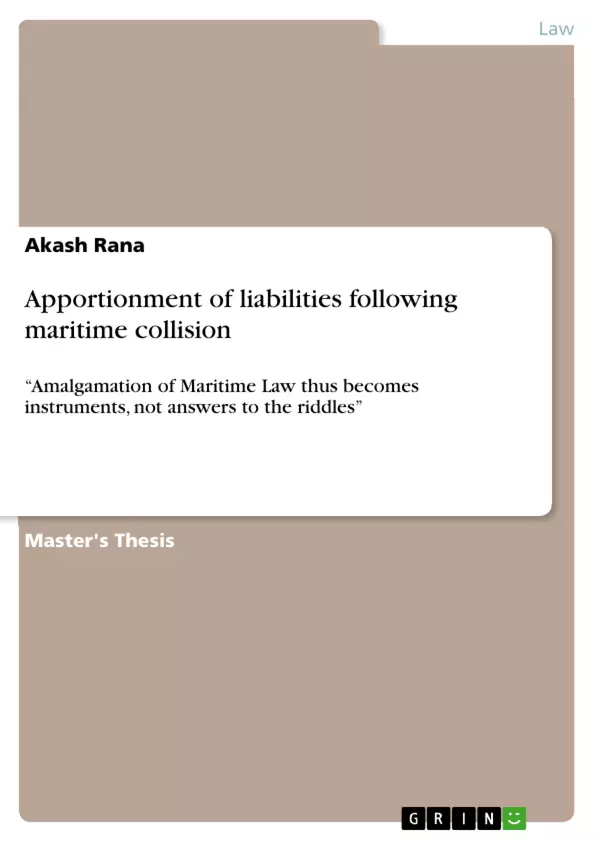The most distinguishing and important characteristic of sea transport is a great value possible to carry on-board each ship. Maritime commercial trade I believe is one of the most international industry in itself. A ship registered in one country; owner could be from another country; master and crew could be from third country, carrying cargo of the owners from fourth country, transiting different waters and carrying out commercial activity in other country's judicial boundaries. This makes it unarguably an industry that deals with legislation from so many different jurisdictions. And hence the uniformity in all these various legislation seeks a right balance. Which I feel that, unfortunately, the right balance between this various maritime legislation is still yet to be achieved.
Inhaltsverzeichnis (Table of Contents)
- SUMMARY
- INTRODUCTION
- General
- Duty to maintain proper look-out - Rule 5
- Introduction
- Extra attention in certain areas or under certain conditions
- Look-out by the use of instruments
- Look-out while anchored
- Safe Speed - rule 6
- Safe speed in areas of restricted manoeuvrable waters
- Safe speed in relation to bow- stern wakes
- Reduced visibility
- Small craft and safe speed in darkness.
- Risk of Collision -rule 7
- Action to Avoid Collision - rule 8
- Narrow Channels - rule 9
- Section II - Conduct of Vessels in Sight of One Another.
- The manoeuvre rules 13-15
- Action by Stand-on Vessel - rule 17
- Responsibilities between vessels - Rule 18.
- Section III - Conduct of vessels in Restricted Visibility- Rule 19
- Apportionment of liability.
- Collision with other objects than ships.
- Distribution Of Liabilities
- Only one ship at fault
- Technical failure as the main triggering event.
- Both To Blame...
- 50/50
- 60/40..
- 75/25
- BURDEN OF PROOF
- GENERAL AVERAGE.
- ECONOMICAL CONSEQUENCES.
- LAW AND ECONOMICS
- CARGO INSURANCE.
- P&I INSURANCE
- STRICT LIABILITY OF BILL OF LADING
- FREIGHT.
- RECOURSE AGAINST THE CARRIER'S SERVANT
Zielsetzung und Themenschwerpunkte (Objectives and Key Themes)
This thesis aims to provide a comprehensive understanding of collision liability between vessels, apportionment of liabilities, and how the amalgamation of various maritime laws and regulations serves as an instrument rather than a definitive answer to the complex issues arising from maritime collisions. The work delves into the consequences of collisions, focusing on damage to vessels, crew, cargo owners, and the state.
- International Regulations for Preventing Collisions at Sea 1972 (COLREGs) and their application in maritime collision scenarios
- Apportionment of liability in collision cases, exploring different scenarios and tendencies
- The concept of "Nautical Fault" as a defense against cargo liability
- The evolution of maritime legislation and rules, particularly the impact of Harter's Act, Hague Rules, Hamburg Rules, and Rotterdam Rules
- Economic consequences of maritime collisions, encompassing aspects like cargo insurance, P&I insurance, and strict liability of the bill of lading
Zusammenfassung der Kapitel (Chapter Summaries)
- Introduction: This chapter provides a general overview of the thesis's scope and objectives. It establishes the importance of understanding collision liability and the role of maritime law in addressing such incidents. The chapter introduces the concept of "Nautical Fault" and its historical development, highlighting the evolution of carrier responsibilities under various maritime conventions.
- COLREGs: This chapter delves into the International Regulations for Preventing Collisions at Sea 1972 (COLREGs). It explores the specific rules governing maritime navigation, including those related to maintaining proper lookout, safe speed, risk of collision, and action to avoid collision. The chapter also analyzes the rules concerning navigation in narrow channels and restricted visibility.
- Apportionment of Liability: This chapter examines the distribution of liability in collision cases. It explores different scenarios, including cases where only one ship is at fault and those involving technical failures. The chapter also investigates the apportionment of liability when both vessels are deemed to be at fault, analyzing various proportions of responsibility.
- BURDEN OF PROOF: This chapter discusses the legal principles and procedures related to establishing the burden of proof in collision cases.
- GENERAL AVERAGE: This chapter delves into the concept of general average, a maritime law principle that allows for the distribution of losses incurred to save a vessel and its cargo among all parties with an interest in the voyage.
- ECONOMICAL CONSEQUENCES: This chapter explores the economic implications of maritime collisions. It discusses various aspects, including law and economics, cargo insurance, P&I insurance, strict liability of the bill of lading, freight, and recourse against the carrier's servant.
Schlüsselwörter (Keywords)
The primary focus of this dissertation lies in the realm of maritime collision liability, encompassing key concepts such as COLREGs, apportionment of liability, Nautical Fault, collision prevention, maritime legislation, and economic consequences of collisions. The work examines the interplay of different legal regimes and their application to collision cases, providing a comprehensive analysis of the legal and practical challenges faced in navigating these complex situations.
- Quote paper
- Akash Rana (Author), 2014, Apportionment of liabilities following maritime collision, Munich, GRIN Verlag, https://www.grin.com/document/301416



